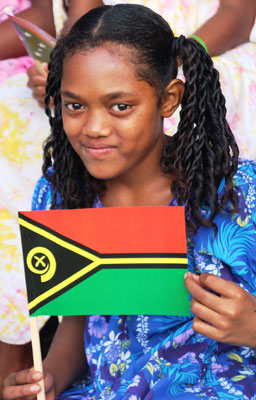Port Vila, Vanuatu — The least-known cruise destination?
This item appears on page 59 of the October 2013 issue.
(Part 1 of 2)
Most Americans have never heard of Vanuatu, and even fewer have heard of its capital, Port Vila. Yet Vila, as it is often called, is becoming a major cruise destination, with about 140 port visits planned by cruise lines over the next 12 months, or about one every two or three days.
The vast majority of these cruise visits are one-day stops by ships of P&O Cruises (phone, in Australia, 1300 159 454), sailing out of Sydney and Brisbane on a one-week loop around the Coral Sea east of Australia, and Carnival Cruise Lines (888/227-6482), with similar itineraries. There are a few 10-day P&O Cruises itineraries from Auckland that include Vila.
Of course, you can fly to Vila, with connections via Brisbane, Sydney, Auckland or Fiji, but all air routes to Vila from the US are a bit painful. For instance, it took me 36 hours of traveling to get from Washington, DC, to Vila by air! So I recommend sailing to Vila via cruise ship as a side journey when you visit Australia.
An introduction
The country of Vanuatu was known as the New Hebrides until 1980, when it achieved independence from the joint Anglo-French Condominium (widely known as “The Pandemonium”). That government wasn’t so much despotic as insane, with two school systems (British and French), two governors (ditto), two police forces, two court systems, two currencies and even two jails!
Vila has one of the prettiest harbors in the South Pacific. Surrounded by steep hills, the remnants of an extinct volcano, the town lies in a large bay on Efate island and is protected by two small, picturesque barrier isles. Numerous anchored yachts dot the smooth waters in front of the town.
Vila’s population of 40,000 is spread out over several square miles, but the downtown is quite small, only about eight blocks between two one-way streets.
By the way, there is no point in my giving any addresses, since there are no street numbers and there are only three street signs in the entire city. Even the locals have no idea what the street names are! Just tell your driver your destination.
What to expect
Vila and Vanuatu are attractive to visitors because of some of the things that won’t be found there: stoplights, parking meters, parking garages, motorways or income tax!
The architecture in Port Vila’s downtown is not distinguished and is comprised mainly of 2-story concrete-slab buildings, with one 6-story hotel, the Grand Hotel. The sidewalks often are irregular, so take care.
The most interesting building is the central market, an open, gabled structure about 30 feet tall and 200 feet wide, with numerous tables laden with exotic fruits, vegetables and nuts, live coconut crabs tied up in stacks, a dozen varieties of bananas, and prices as low as one US dollar for a bunch of 12 monkey bananas.
Chat with some of the lady vendors, almost all of whom live on north Efate island or on out islands. They take their produce into town on Monday morning and sleep on the concrete floor of the market each night, beside their wares.
You will get off your ship in the wharf area about one mile south of downtown. Inspect the many stalls with T-shirts and souvenirs just beyond the port gates.
The drivers from Tanna island are rather aggressive and, so, have a lock on the business provided by the arriving passengers. Walk past these touts and take pity on the other drivers, hiring one of their vans at the end of the row of stalls.
Transport — only $1.60 for five miles
Transport around town is generally via the 1,000-odd vans that trundle slowly up and down the main north-south road (rumored to be called Lini Highway after the founder of the country). These vans charge only $1.60 to take you five miles, one of the best bargains around. Since the vans are entirely unregulated, they often are grubby, and watch out for potholes and rocks when you hop out.
The vans are jitneys, so they go where you and others want, sometimes resulting in long detours. If you are in a hurry, take a taxi for about $7-$10; it’s somewhat negotiable. There are no taxi meters in the whole country.
Next month I will tell you about cool things to do and the best restaurants in Port Vila.


